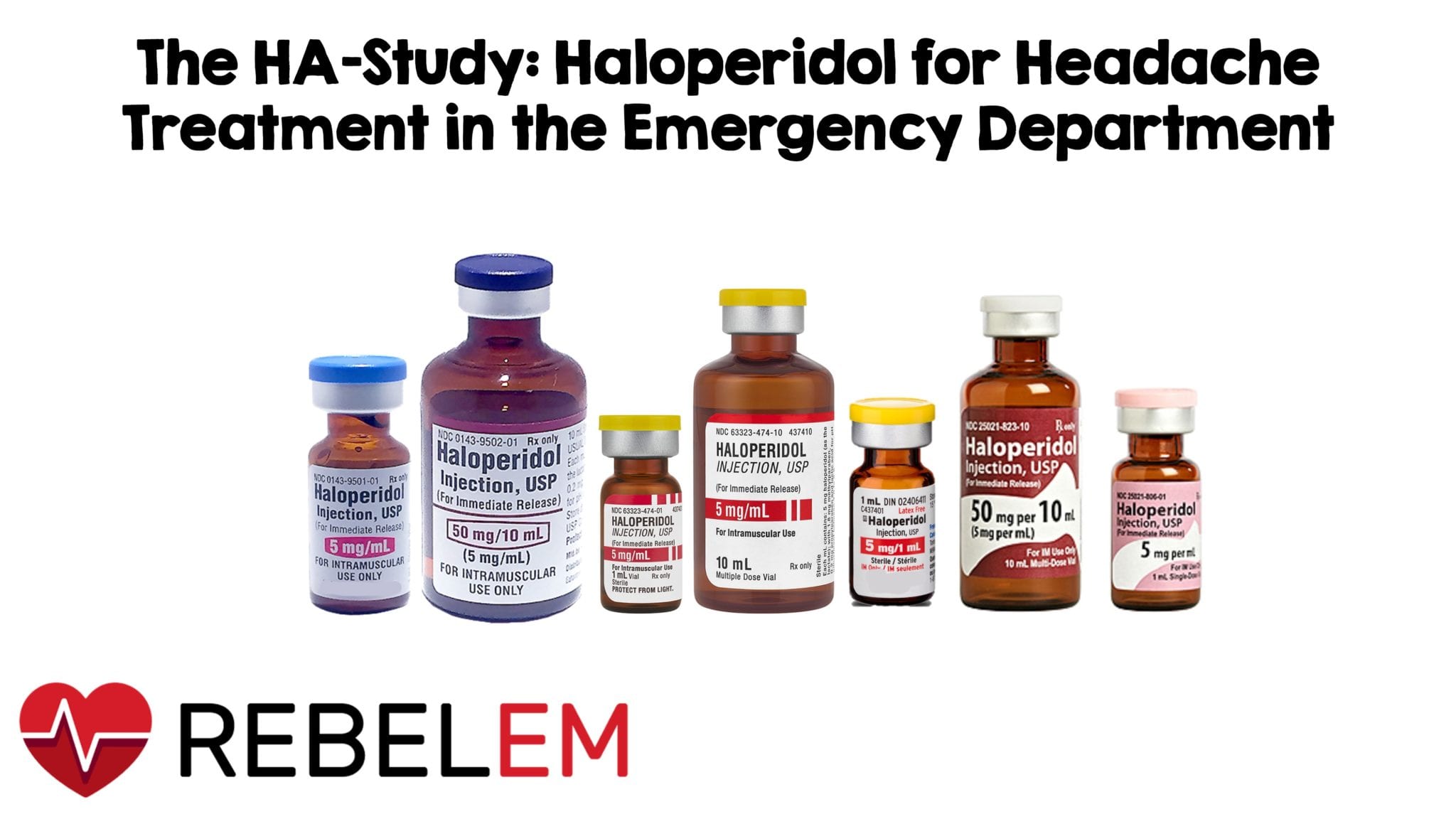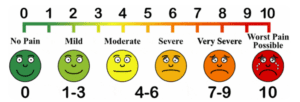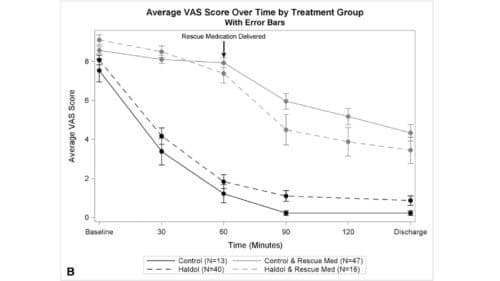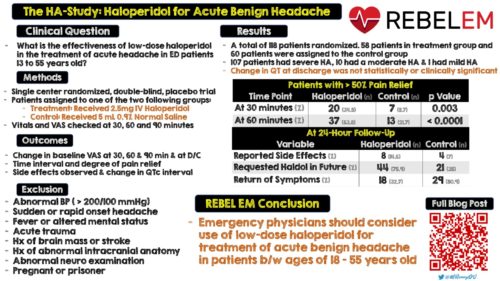Background Information:
 Headache is a common chief complaint that emergency physicians encounter almost every day and sometimes multiple times in each shift. In fact, headache is the fifth leading cause of patients presenting to the emergency department (ED).1 Current first-line treatment consists of a dopamine antagonist such as prochlorperazine or metoclopramide which are given in addition to diphenhydramine to mitigate any potential adverse effects. A recent study has shown that IV haloperidol, another dopamine antagonist, was equivalent to IV metoclopramide in the successful treatment of headaches in the ED.2 Additionally, haloperidol has been shown to be an effective rescue medication in the treatment of refractory migraine-pain.3 Unfortunately, the cardiovascular effects and reported QTc prolongation associated with haloperidol has limited its use in the ED. The authors of the following study sought to determine the effectiveness of low-dose IV haloperidol in the ED treatment of acute benign headache among patients aged 13 to 55 years old
Headache is a common chief complaint that emergency physicians encounter almost every day and sometimes multiple times in each shift. In fact, headache is the fifth leading cause of patients presenting to the emergency department (ED).1 Current first-line treatment consists of a dopamine antagonist such as prochlorperazine or metoclopramide which are given in addition to diphenhydramine to mitigate any potential adverse effects. A recent study has shown that IV haloperidol, another dopamine antagonist, was equivalent to IV metoclopramide in the successful treatment of headaches in the ED.2 Additionally, haloperidol has been shown to be an effective rescue medication in the treatment of refractory migraine-pain.3 Unfortunately, the cardiovascular effects and reported QTc prolongation associated with haloperidol has limited its use in the ED. The authors of the following study sought to determine the effectiveness of low-dose IV haloperidol in the ED treatment of acute benign headache among patients aged 13 to 55 years old
Paper: Treatment of Headache in the Emergency Department: Haloperidol in the Acute Setting (THE-HA Study): A Randomized Clinical Trial. J Emerg Med 2020. PMID: 32402480
Clinical Question:
- What is the effectiveness of 2.5mg of IV haloperidol compared to placebo in the treatment of acute headache in ED patients aged 13 to 55 years old?
What They Did:
- This was a single center, prospective, randomized, placebo-controlled double-blinded trial conducted in a community-based teaching hospital and level I trauma center that sees approximately 100,000 visits annually.
- Patients were identified by triage nursing staff and then randomized by the on-call investigator to either the treatment or control group using standard sequential envelope randomization performed by a third party.
-
- Treatment group: Received 2.5mg of IV haloperidol diluted with 0.9% sodium chloride to a final concentration 5 mL pushed slowly over 1 to 2 minutes
- Control group: Received 5 mL of 0.9% sodium chloride
- After drug administration, vital signs, pain score and side effects were documented for both groups at 0, 30, 60 and 90 minutes.
- Patients were on cardiac monitoring throughout their ED stay and had their QT measured prior to medication administration and at discharge.
- Headache pain was measured using the patient-reported visual analog scale (VAS) which quantifies pain as 0 being no pain and 10 as the worst possible pain
- If patients did not have at least a 50% reduction in their VAS score at 60 minutes they were offered rescue medication. IV ketorolac 30mg for adults and 15mg for patients 13 to 17 years old or weighing < 50 kg. If there was an allergy to ketorolac, 10mg IV metoclopramide was offered instead. These patients were then observed for an additional 60 minutes with repeat VAS and vital signs.
- Headache resolution was defined by the authors as a VAS pain score of 0 or 1 at 30, 60, 90 minutes or at discharge
- If the study and rescue medication failed to improve the patient’s symptoms at 120 minutes, additional treatment was left at the discretion of the emergency medicine physician.
- A phone call was made 24 hours after discharge to collect follow-up data and included the following:
- Repeat VAS
- Occurrence of any side effects from medication
- Reported return of symptoms by 24 hours
- Any subsequent medical visits due to headache (primary care or ED visit)
- Patient preference for requesting study drug for treatment of future headache

Visual Analog Survey (VAS) Scale Infographic by Great Brook (image source here)4
Inclusion Criteria:
- Patients aged 13 to 55 years old presenting to the emergency department with the chief complaint of headache or migraine
Exclusion Criteria:
- Patients with any of the following were excluded:
- Abnormal blood pressure (> 200/100 mmHg)
- Sudden or rapid onset (normal to worst pain in minutes)
- Fever
- Acute trauma
- History of brain mass
- History of stroke
- History of abnormal intracranial anatomy
- QT > 450 ms on electrocardiogram
- Altered mental status (GCS <15)
- Allergy to haloperidol
- Abnormalities on neurological examination
- Pregnant Patients
- Patients who were prisoners
- Any clinician concern that would require computed tomography imaging of the brain
Outcomes:
Primary
- Change in baseline VAS at 30, 60, 90 minutes and at discharge after study drug was administered.
Secondary
- Time interval to pain relief
- Degree of pain relief (measured in percent reduction of VAS at each time point)
- Side effects observed
- Change in QT interval
Results:

- A total of 118 patients were randomized into the two groups. 58 patients were in the haloperidol group and 60 were in the placebo group
- 107 patients (90.7%) had a severe headache defined as a VAS score greater than 7
- 10 patients (8.5%) had a moderate headache defined as a VAS score between 4 and 6
- 1 patient had a mild headache, which was a VAS score less than 4
- Of the 118 total patients, 86 (72.9%) were female
Critical Results:


Mean pain scores comparing both groups with rescue medication from time 0 to discharge.
(Image from paper)
- The haloperidol group reported a mean 4.77-unit reduction in VAS at 60 minutes compared to a 1.87-unit reduction in the placebo group
- In the haloperidol group, 18 patients (31%) reported inadequate pain and required rescue medication compared to the placebo group where 47 patients (78.3%) had inadequate pain relief and also required rescue medication
- Of all the patients in the haloperidol group, 34 (58.6%) had complete resolution of their headache prior to discharge, reporting a 0 to 1 on VAS.
- 9 patients reported anxiety or restlessness as a side effect had complete resolution of their symptoms. 7 had received benadryl and 2 received lorazepam at 30 minutes.
- The mean change in QT at discharge was not statistically different or clinically significant. There were no observable dysrhythmias in either group and there was no clinically significant increase in heart rate observed

Strengths:
- Largest prospective cohort and randomized control trial on this subject to date. This is the first RCT utilizing low-dose haloperidol of 2.5mg for treatment of acute headache.
- All physicians, nurses, patients, and providers were blinded to treatment group
- Patients were well balanced between groups in terms of weight, age and pain severity at baseline
- Implemented a 24-hour phone call interview to assess return of symptoms, adverse effects and need for additional care. 95% of the patients were reached for this follow-up.
- The authors found haloperidol’s efficacy was unchanged between those previously diagnosed with migraines and those who were not.
- Utilized a well thought out rescue plan tailored to adults and patients aged 13 to 17 as well as those who may have an allergy to ketorolac.
- Authors thought out a method to treat akathisia, including a plan if that patient had an allergy to benadryl
Limitations:
- Small sample size made even smaller by the fact that 5 patients left the study prior to completion of the study requirements. A sample size of 71 patients per group was required to provide an 80% power to detect an effect size.
- Other confounding variables were not mentioned such as who was placed in a dark, quiet room.
- Despite a randomized double-blinded protocol and happening by chance alone, females represented the majority in both control and experimental groups. This emphasizes the importance of having larger trials.
- Convenience sampling of patients occurred for 20 hours per day and not between the hours of 4am and 8am due to lack of ED pharmacists during these times
- All patients had improvement of their headache and did not want to wait for the 60- and 90-minute data collection
- Although study included pediatric patients in their inclusion criteria the small sample size limits any conclusions as only 5 of these 9 patients received haloperidol.
Discussion:
- Migraine is a complicated diagnosis that requires a thorough outpatient neurological evaluation. Additionally, their trigger and treatment can be even more complex as it can widely vary patient-to-patient. Although the authors attempted to include “history of migraine” as an important data capture point, this may be too general and broad of a grouping. A more accurate measure of migraine severity may be the frequency of outpatient neurology follow-up in these patients.
- The authors performed an unplanned interim analysis due to a large proportion of patients having headache resolution. Although the authors state this interim analysis revealed excellent power and significant result with 118 patients, one must wonder if the results would be as significant if the study was continued (ie. regression to the mean)
- Instead of comparing to a specific medication, the authors compared the experimental group to a placebo consisting of only a saline flush. The placebo effect can be observed in this study as 14 patients in the control arm had a greater than 50% reduction of pain at 60 minutes with administration of 5 mL 0.9% sodium chloride alone
- Akathisia was only experienced in 13.8% of haloperidol treated patients (which was not statistically significant) which is in line with prior reports of a low side effect profile with 2mg of haloperidol
- The incidence of akathisia was significantly lower in this trial compared with previous reports, leading the authors to suggest the pre-treatment with diphenhydramine is unnecessary when using haloperidol at this 2.5mg dose.
- The authors’ questions at follow-up included important and relevant points for the emergency physician, specifically the return of symptoms and the patient’s need to seek additional care. It’s important to note that the haloperidol group experienced less return of symptoms and less need for additional care after 24 hours when compared to the control group
- The use of a saline flush and a dark quiet room in the control group had a greater than 50% reduction of pain at 60 minutes. The authors do not mention if patients in the experimental group were placed in a dark, quiet room which may have skewed the results.
- No QT prolongation occurred in any of the patients receiving haloperidol. Therefore, the authors suggest that obtaining an electrocardiogram prior to low-dose haloperidol administration may not be necessary.
- Patient’s preference for a specific medication and involvement in their future care was factored into the follow-up phone interview as noted by 77% of patients reported they would request haloperidol again for their headache.
- It’s unclear why the authors attempted to include pediatric patients in this study. They recognize the potential variables that may have contributed to their small sample size (ie. decreased incidence of severe headache in this group, difficulty obtaining parental consent, etc).
- It is important to recognize this small sample size study applies benign headache treatment. The authors recognize this as they state a larger sample size is needed to determine the frequency of misclassification of serious headaches as benign.
Author’s Conclusions:
- This study suggests that 2.5 mg IV haloperidol is a rapid and effective treatment for acute, severe, benign headache in ED patients aged 18 to 55 years. Further study is warranted to confirm these results in adolescents
Our Conclusion:
- Although a small sample size, the use of low dose IV haloperidol appears to be effective in the acute treatment of benign headaches in the adult emergency department patient. The low adverse effects observed in this study, specifically QT prolongation, suggest that the use of haloperidol may be a safe first line agent in the treatment of benign headache. Given the small sample size of pediatric patients in this study, these findings cannot be applied to patients under the age of 18 years old until additional research has been performed.
Clinical Bottom Line:
- With a low side-effect profile, emergency physicians should consider the use of 2.5 mg IV haloperidol as a rapid and effective treatment for acute benign headache in adult emergency department patients aged 18 to 55 years old.

Infographic Summary created by Mark Ramzy (@MRamzyDO)
For More Thoughts on This Topic Checkout:
- St. Emlyn’s Blog: Haloperidol for Headaches
REFERENCES:
- McCoy JJ, et al. Treatment of Headache in the Emergency Department: Haloperidol in the Acute Setting (THE-HA Study): A Randomized Clinical Trial. J Emerg Med. Published online May 2020. PMID: 32402480
- Gaffigan ME, et al. A Randomized Controlled Trial of Intravenous Haloperidol vs. Intravenous Metoclopramide for Acute Migraine Therapy in the Emergency Department. J Emerg Med. 2015; PMID: 26048068
- Honkaniemi J, et al. Haloperidol in the Acute Treatment of Migraine: A Randomized, Double-Blind, Placebo-Controlled Study. CME. Headache J Head Face Pain. 2006; PMID: 16643581
- Visual Analog Survey Scale — A Pain-ful Misnamed Scale. Great Brook Consulting. Published January 10, 2019. Accessed July 4, 2020. Link here
Post Peer Reviewed By: Salim R. Rezaie, MD (Twitter: @srreziae)
The post Haloperidol for Treatment of Headache in the Emergency Department appeared first on REBEL EM - Emergency Medicine Blog.
